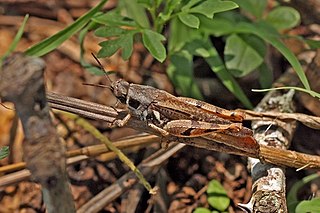
The subfamily Catantopinae is a group of insects classified under family Acrididae. Genera such as Macrotona may sometimes called "spur-throated grasshoppers", but that name is also used for grasshoppers from other subfamilies, including the genus Melanoplus from the Melanoplinae.

Bandwings, or band-winged grasshoppers, are the subfamily Oedipodinae of grasshoppers classified under the family Acrididae. They have a worldwide distribution and were originally elevated to full family status as the Oedipodidae. Many species primarily inhabit xeric weedy fields, and some are considered to be important locusts:
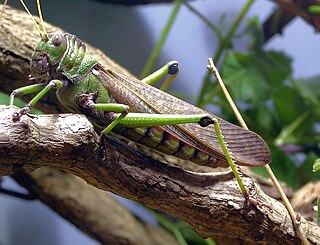
The Romaleidae or lubber grasshoppers are a family of grasshoppers, based on the type genus Romalea. The species in this family can be found in the Americas.
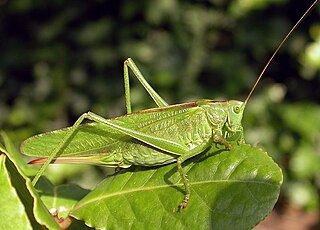
The Tettigoniinae are a subfamily of bush crickets or katydids, which contains hundreds of species in about twelve tribes.

Isophya is a genus of bush crickets, in the tribe Barbitistini, found from mainland Europe to western Asia.

The Phaneropterinae, the sickle-bearing bush crickets or leaf katydids, are a subfamily of insects within the family Tettigoniidae. Nearly 2,060 species in 85 genera throughout the world are known. They are also known as false katydids or round-headed katydids.
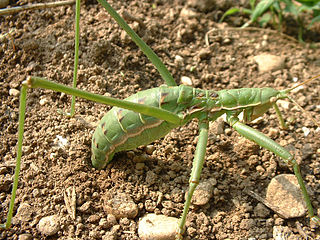
Saga is a genus of bush crickets or katydids containing around 15 species as of 2018. It is the only genus in the tribe Sagini and belongs to the subfamily Saginae. Species have been recorded from southern Europe and western and central Asia.

Oxyinae is subfamily of grasshoppers in the family Acrididae. Species are distributed throughout Africa and Australasia.
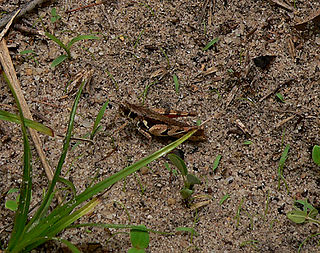
Catantopini is a tribe in the subfamily Catantopinae, a group of grasshoppers found in Africa, Asia and Australia.

The Eyprepocnemidinae are a subfamily of Acrididae in the Orthoptera: Caelifera. Species can be found in Africa, mainland Europe and Asia.
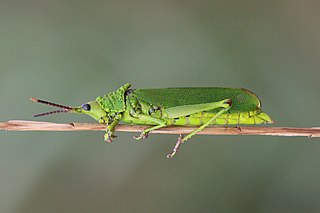
The Pyrgomorphinae are a sub-family of grasshoppers in the family Pyrgomorphidae. Species are found in, especially the warmer parts of: Central and South America, southern Europe, Africa, Asia, Australia and Pacific Islands. The type genus is Pyrgomorpha and names dates from "Pyrgomorphiden" by Brunner von Wattenwyl, 1874. The first use of Pyrgomorphinae was by Krauss in 1890.
Himertula is a genus of bush crickets in the subfamily Phaneropterinae and tribe Letanini. Species can be found mostly in the Indian sub-continent.
Psyrana is a genus of Asian bush crickets of the tribe Holochlorini within the subfamily Phaneropterinae. They occur in Sri Lanka Indo-China, China, Korea, Japan, and Malesia to New Caledonia.

Poecilimon is a genus of bush crickets in the subfamily Phaneropterinae and tribe Barbitistini. Species can be found in: central and Southeast Europe, the south of the European part of the former USSR, Asia Minor, Syria, Palestine, the Caucasus, Persia and extends in Central Asia to the Altai mountains.
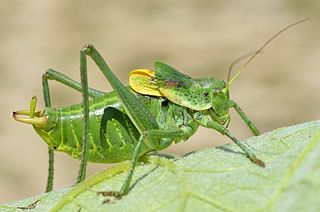
Polysarcus is a genus of bush crickets in the subfamily Phaneropterinae and tribe Barbitistini. Species can be found in western Europe, Middle East through to Afghanistan.

Anterastes is a genus of Palaearctic bush crickets in the tribe Platycleidini, erected by Carl Brunner von Wattenwyl in 1882. Species can be found in South-eastern Europe, with most records from the Balkans, Greece and Turkey.

Pachytrachis is a genus of Palaearctic bush crickets in the tribe Platycleidini, erected by Boris Uvarov in 1940. Species have been recorded from Italy, through South-eastern Europe to Turkey.
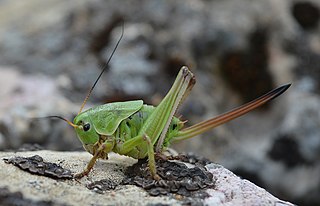
Psorodonotus is a genus of Palaearctic bush crickets in the tribe Pholidopterini, erected by Carl Brunner von Wattenwyl in 1861.
Paracaloptenus is a genus of Palaearctic grasshoppers in the subfamily Calliptaminae, erected by Ignacio Bolívar in 1878. Records of occurrence are from Spain and France, with a discontinuous distribution through to Ukraine and Turkey.
















